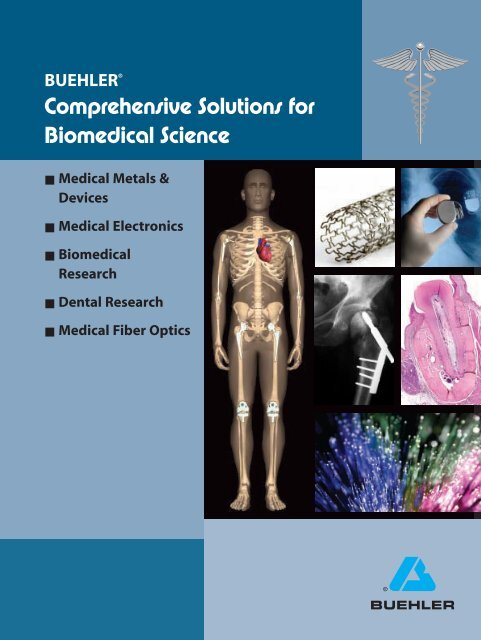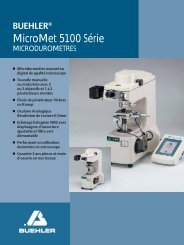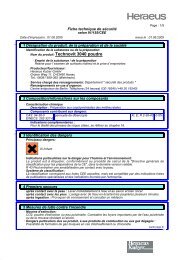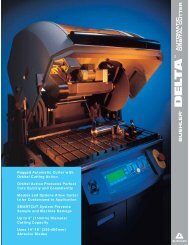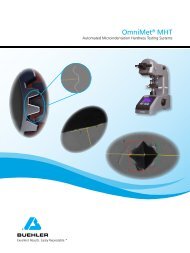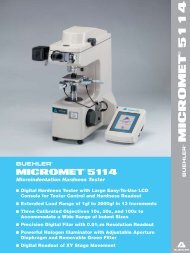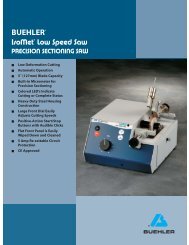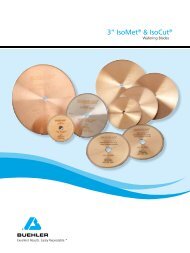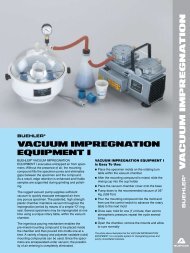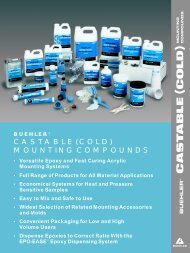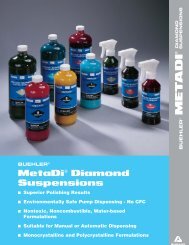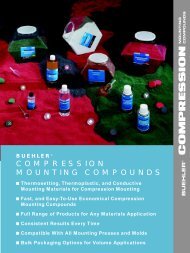You also want an ePaper? Increase the reach of your titles
YUMPU automatically turns print PDFs into web optimized ePapers that Google loves.
BUEHLER ®<br />
Comprehensive Solutions for<br />
Biomedical Science<br />
■ Medical Metals &<br />
<strong>Devices</strong><br />
■ Medical Electronics<br />
■ Biomedical<br />
Research<br />
■ Dental Research<br />
■ Medical Fiber Optics
Table of Contents<br />
� Introduction<br />
� Sectioning of<br />
Medical<br />
Materials &<br />
<strong>Devices</strong><br />
� Specimen<br />
Mounting<br />
� Grinding &<br />
Polishing<br />
� Image Analysis<br />
Software &<br />
Microindentation<br />
Hardness Testing<br />
� Medical<br />
Electronics<br />
Preparation for<br />
Failure Analysis<br />
� Customer<br />
Support &<br />
Education<br />
2<br />
<strong>Buehler</strong><br />
As a world leader in specimen preparation equipment for the medical community,<br />
<strong>Buehler</strong> supports medical device manufacturers, medical material suppliers,<br />
biomedical and dental researchers and medical electronic manufacturers. Our<br />
products help to advance scientific knowledge which improves manufacturing<br />
and quality, while increasing enhanced understanding of the end results.<br />
<strong>Buehler</strong> manufactures scientific equipment and consumables for use in materials<br />
analysis. Our products are used throughout the world for product development,<br />
manufacturing, academic research and maintaining quality control. Everything<br />
needed to equip or retrofit your laboratory for sectioning, mounting, grinding and<br />
polishing to final analysis with a complete line of microscopes and image analysis<br />
systems is available.<br />
Our capabilities are broad, as we are able to offer proper equipment, consumables<br />
and methods for a wide variety of material applications. Medical device<br />
manufacturers face very stringent material properties that require extensive<br />
testing. These materials must be accepted by the human body and continue to<br />
function over a long period of time. Implantables and other orthopedic devices<br />
must resist wear in a highly corrosive environment. There is a growing trend<br />
toward smaller devices with increased mechanical performance. Whether you are<br />
preparing hip/knee implants or an apparatus as small as a drug-eluting stent,<br />
<strong>Buehler</strong> can provide a method which includes the best equipment and<br />
consumables for microscopic cross-sectional analysis.<br />
This brochure outlines some challenges that the medical community faces when<br />
preparing specimens for analysis. Solutions are met in a variety of ways using<br />
<strong>Buehler</strong> expertise, specialty equipment, consumables and services in the medical<br />
electronics failure analysis, histology and fiber optics markets. Our educational<br />
programs offer in-depth knowledge, support and demonstration of equipment<br />
and consumables.
MetAbrase® Abrasive Cut-off<br />
Wheels<br />
IsoMet® 5000 Linear Precision Saw.<br />
Options include a Bone Chuck,<br />
Glass Slide Chuck and Irregular<br />
Specimen Chuck.<br />
IsoCut® and IsoMet® Wafering<br />
Blades<br />
Sectioning of Medical<br />
Materials & <strong>Devices</strong><br />
Health related devices consist of a variety of materials with diverse properties.<br />
They include, but are not limited to metals, alloys, ceramics, polymers and<br />
carbonaceous materials. The main concern in cross-sectioning is to obtain a<br />
surface with minimal damage. <strong>Buehler</strong> offers a wide variety of abrasive cutters and<br />
precision saws for the medical industry.<br />
Larger devices, such as hip or knee implants, require the use of abrasive cutters as<br />
the first step of metallographic preparation. These materials may also be coated to<br />
enhance their performance or biocompatibility. Porous metal or ceramic coatings<br />
deposited on implants are applied to facilitate bone ingrowth. The coatings must<br />
be protected to view the true microstructure. All of <strong>Buehler</strong>’s abrasive cutters and<br />
MetAbrase® Abrasive Cut-off Wheels are specially designed to produce minimum<br />
deformation without sacrificing cutting rates.<br />
Specialized applications may arise in the study of histological specimen<br />
preparation. For example, when preparing a stent implantation, the metal and<br />
tissue interface must be prepared without distortion. Drug-eluting stents (Au<br />
sputter coated for drug protection) can be cross-sectioned without damaging the<br />
drug layer, so that the adhesion and uniformity of the drug can be viewed. The<br />
stent should be mounted in an epoxy, for ease of handling, before sectioning.<br />
<strong>Buehler</strong>’s abrasive and precision saws come with a variety of vises and fixtures<br />
which accommodate most of the medical industries needs. The largest<br />
abrasive saws can handle specimens up to 6″ (170mm) in diameter. Any of<br />
<strong>Buehler</strong>’s IsoMet® Precision Saws can easily resection a specimen, with minimal<br />
surface damage, when used with the IsoCut® and IsoMet® Wafering Blades. These<br />
proprietary blades were developed specifically to offer accurate sectioning.<br />
Pryolitic heart valve cross-section.<br />
3
SimpliMet® 3000 Automatic<br />
Mounting Press has short heating<br />
and cooling times.<br />
Cast N’ Vac 1000 Vacuum<br />
Impregnation System for impregnation<br />
of pourous specimens.<br />
EpoHeat® Epoxy is excellent for<br />
vacuum impregnation. It is a fast,<br />
heat curing epoxy with low<br />
shrinkage & viscosity.<br />
4<br />
Acetabular Cup mounted in<br />
EpoHeat® Epoxy.<br />
Specimen Mounting<br />
First, the specimen is sectioned to a workable size. Next, it is normally mounted for<br />
grinding and polishing. Finally, it is ready for microscopic examination. Depending<br />
on the type of specimen being prepared, mounting alternatives encompass three<br />
different methods.<br />
Compression Mounting<br />
This process is performed in a mounting press. Specimens are placed in the press<br />
chamber and a suitable resin is poured over the specimen. Presses, such as the<br />
SimpliMet® 1000 or 3000 Automatic Mounting Press, are quick and easy to use.<br />
They offer short heating and cooling times, and also provide excellent edge<br />
retention of a specimen when used with the proper mounting media. Importance<br />
here lies with edge microscopy analysis such as medical implants that have<br />
coatings to retain the edge in its original condition. However, compression<br />
mounting is not suitable for heat-or pressure-sensitive samples. A full list and<br />
description of mounting resins can be located in the <strong>Buehler</strong> Consumables Buyer’s<br />
Guide.<br />
Castable Mounting Compounds<br />
With specimens that are sensitive to high pressures and temperatures, it is<br />
recommended to mount them using a castable epoxy resin. There are many<br />
options to consider when choosing a suitable epoxy. Variables include cure time,<br />
peak temperature during the curing cycle, hardness and level of edge protection.<br />
Other properties important to think about are viscosity for filling small voids,<br />
transparency and if the epoxy can be used under a vacuum. Use of the Cast N’ Vac<br />
Impregnation Vacuum System can assist in filling small fragile pores without<br />
damaging them during the mounting process and enhance edge protection. An<br />
example of a specimen mounted with EpoHeat® Epoxy under a vacuum is shown<br />
below with this sectioned Acetabular Cup.<br />
Specialty Castable Glass Slide Mounting<br />
When evaluating tissue or bone response adjacent to the implanted biomaterial, it<br />
is important to maintain true architecture for histological examination. <strong>Buehler</strong> can<br />
assist the pathologist with proper cutting, grinding and polishing methods. Glass<br />
slide mounted specimens are typically thinned to 5-10 microns. Appropriate<br />
technique is essential when dissimilar materials, such as a hard implant, are in<br />
contact with a much softer bone or tissue. Embedding epoxy is commonly done in<br />
the preparation of specimens that will be analyzed using an electron microscope.<br />
Microstructure of Acetabular<br />
Cup, Ti-6Al-4V Substrate with CP<br />
Ti Powder.<br />
Cast dendritic microstructure of ASTM F75, Co-28% Cr-8%<br />
femoral knee implant.
EcoMet® 250 Grinder-Polisher &<br />
AutoMet® 250 Power Head<br />
Histolic Glass Slide Holder for<br />
controlled material removal.<br />
PetroThin® Thin Sectioning System<br />
for preparing glass slide mounted<br />
thin sections.<br />
Grinding & Polishing<br />
<strong>Buehler</strong> offers the medical industry a choice when selecting the right<br />
grinder-polisher. Our EcoMet® family is designed to meet their needs. This product<br />
line offers medical implant manufacturers options for preparing samples in single<br />
or central force modes when combined with an AutoMet® Power Head. Select a<br />
platen of 8″ (200mm), 10″ (250mm) or 12″ (300mm) based on size and volume of<br />
specimens to be prepared each day. The EcoMet® Pro is controlled by a<br />
touch-screen and offers additional features including Zaxis, with Macro Material<br />
Removal System which allows the operator to remove material by depth in central<br />
force only. The EcoMet® family of grinder-polishers comes with a large variety of<br />
specimen holders for central and single force operations.<br />
Specialty holders are also available for histological specimen preparation. For<br />
example, the Histolic Glass Slide Holder is used for thinning specimens mounted to<br />
glass slides. These can be used for hand polishing or can be mounted in a<br />
specimen holder and used semi-automatically with the EcoMet® 300 and the<br />
AutoMet® 300 which uses a 12″ (305mm) diameter platen. Such holders provide<br />
controlled material removal by depth while retaining sample flatness because they<br />
grind only to the stop ring.<br />
Preparation of Thin Sections<br />
The PetroThin® Thin-Sectioning System is used for precision thinning of<br />
histological specimens. It is designed to cut and grind a specimen which is first<br />
mounted on a glass slide. By mounting a specimen on a glass slide, the same plane<br />
is maintained during preparation. However, it is recommended for medical<br />
applications that the specimens are cut with an IsoMet Precision Saw first, and<br />
then ground with the PetroThin. <strong>Buehler</strong>’s IsoMet Precision Saws offer thinner<br />
blades (less kerf loss) that minimize tissue damage and preserves the specimen.<br />
Specimens prepared on the PetroThin can be thinned to 50-100 microns. Further<br />
thinning would then be performed using the Histolic Glass Slide Holders<br />
discussed previously.<br />
Cross-section of drug coated stent, 4x. Cross-section of a drug coated stent,<br />
gold coated to protect the drug<br />
during preparation, 500x.<br />
Thin section of a stented artery showing<br />
the tissue stent interface.<br />
5
OmniMet® Modular Digital<br />
Imaging System Screenshot<br />
6<br />
Image Analysis Software &<br />
Microindentation Hardness<br />
Testing<br />
Skin lotion is being analyzed for the amount of quantification of fat cells in different sizes. The purple image shows bone marrow smear.<br />
Microhardness indentations in a<br />
tooth. The large indent shows that<br />
the dentine is much softer than the<br />
enamel (smaller indent).<br />
Image Analysis Software<br />
OmniMet® Modular Digital Imaging Systems cover the gamut from a simple image<br />
archiving and database management tool to a fully functional suite of applications<br />
for the medical industry. The OmniMet® Capture Advanced System incorporates<br />
database management tools, basic image processing and measurement functions<br />
(including feature classification and counting), as well as full reporting capabilities<br />
that will help support Part 11 of Title 21 Code of Federal Regulations (21CFR Part<br />
11). These guidelines were prepared to meet FDA requirements for electronic<br />
records and electronic signatures. In addition, there are specific application<br />
modules for object measurement analysis, weld, hardness testing and grain size<br />
evaluation. Tubing made of high performance polymers and nitinol for making<br />
stents and catheters can easily be measured and documented using an OmniMet<br />
system. In using the secure OmniMet® Database, you can easily link all of your<br />
OmniMet® Software Systems together throughout the world. Sharing laboratory<br />
information has never been easier.<br />
Microindentation Hardness Testing<br />
Microindentation hardness testing is used throughout the medical and dental<br />
industries. Applications include evaluating curing methods for dental resins,<br />
characterizing orthopaedic implant materials prior to fabrication, and determining<br />
coating hardness and component hardness profiles. Microhardness systems utilize<br />
Vickers or Knoop indenters at low test loads, from 0.5gf to 2000gf. The Vickers<br />
test uses a square diamond shaped indenter while the Knoop test uses an<br />
elongated diamond indenter. Knoop indents are shallower and can be placed<br />
closer together making them more suitable for determining the hardness of<br />
coatings and thin parts.<br />
<strong>Buehler</strong>’s OmniMet® MHT Fully Automated Microindentation Hardness Systems<br />
improve productivity and repeatability through automated profile placement,<br />
turret rotation, objective focusing, and indent measurement. See our Equipment<br />
Buyer’s Guide for details on our system configurations and microhardness testers.
Medical Electronics Preparation<br />
Multilayer flex circuit cross-section,<br />
as polished, at 100x.<br />
Cross-section of soldered wire joint<br />
mounted on a printed circuit<br />
board, at 50x.<br />
Cross-section of soldered<br />
capacitor, etched at 100x.<br />
for Failure Analysis<br />
Throughout the healthcare sector, medical electronics plays an important role.<br />
Diagnostic imaging equipment, portable consumer medical products and<br />
implantables all require the highest quality and reliability. These products have to<br />
meet longer life cycles than typical consumer products and maintaining quality is<br />
of the utmost concern. <strong>Buehler</strong> has a long history of working with medical Original<br />
Equipment Manufacturers (OEM), and more recently, Electronic Manufacturing<br />
Services (EMS) providers, assisting them in specimen preparation for failure<br />
analysis.<br />
Printed Wiring Boards<br />
<strong>Buehler</strong> offers two printed wiring board through-hole cross-sectioning systems to<br />
assist bare board manufacturers in monitoring copper plated through-hole quality.<br />
The NelsonZimmer® 2000 and 3000 Printed Wiring Board Systems provide<br />
cross-sectional semi-automation, accuracy and high volume capabilities for<br />
preparing through-holes. <strong>Buehler</strong>’s newest system, the NelsonZimmer 3000 High<br />
Volume Printed Wiring Board Preparation System, can target the center of plated<br />
through-holes down to 0.004″ (0.10mm) in diameter. Combined with the PWB<br />
Router and Drill, suspected failure sites can be removed anywhere on a bare<br />
printed circuit board.<br />
Microelectronic Components<br />
Failure analysis is an important process in the effort to ensure reliability of<br />
electronic products and systems throughout their product life cycle. Significant<br />
improvements in the reliability of electronics can be achieved by retrieving fielded<br />
products and examining them to determine the root cause of any failure and the<br />
extent of degradation which has occurred over time. Cross-sectional analysis is a<br />
valuable tool for failure analysis of electronic devices, wafers, solid-state devices<br />
and components and a variety of mechanisms used in medical devices.<br />
� BioMEMS<br />
� Flex circuits<br />
� Sensors<br />
� Storage devices<br />
� Miniature components<br />
� Flip Chips<br />
� Electrical connectors<br />
� Bare die<br />
� Packages<br />
� POP-Package-on-<br />
Package<br />
Targeting failure sites or specific points of interest in electronic circuits is<br />
accomplished with controlled material removal systems such as the MPC 2000<br />
Cross-Sectioning and MPC 3000 Backside Grinding Systems. These systems grind<br />
and polish in the Z-axis and are micrometer controlled within ± one micron of a<br />
desired feature. Combined with proper consumables, such as the UltraPrep®<br />
Diamond Lapping Films, these systems can easily grind and polish components of<br />
varying materials.<br />
7
Nitinol martensitic structure after<br />
going through the shape memory<br />
effect at 1000x.<br />
For additional selections of specimen holders, consumables and other accessories, refer to the <strong>Buehler</strong> Equipment Buyers Guide or Consumables Buyers Guide, or contact your local<br />
<strong>Buehler</strong> Sales Engineer. <strong>Buehler</strong> continuously makes product improvements; therefore, technical specifications are subject to change without notice.<br />
© 2008 BUEHLER LTD. Printed in U.S.A. XM0X08 FN0XXXX *For metallurgical equipment produced by BUEHLER LTD. USA<br />
BUEHLER LTD. – Worldwide Headquarters<br />
41 Waukegan Road • P.O. Box 1<br />
Lake Bluff, Illinois 60044-1699 USA<br />
Tel: 847/295-6500 • Fax: 847/295-7979<br />
Sales: 1/800/BUEHLER • 1/800/283-4537<br />
Web Site: http://www.buehler.com<br />
Email: info@buehler.com<br />
Customer Support &<br />
Education<br />
The medical industry can rely on <strong>Buehler</strong> for assistance preparing many different<br />
materials and devices under development or used in the market today. Our<br />
laboratories throughout the world are prepared to tackle your problems by<br />
developing a preferred method to reveal the true structure of your specimen. Send<br />
us your specimen to be prepared before making that final decision on what to<br />
buy. We will recommend the best approach, saving you time and money.<br />
<strong>Buehler</strong> continues to be a leader in educational programs aimed at the medical<br />
industry. “Metallographic Techniques for Medical <strong>Devices</strong>”,“Metallographic<br />
Interpretation” and “Advanced Metallographic Techniques” are just a few<br />
courses available worldwide. Visit the <strong>Buehler</strong> biomedical website at<br />
www.buehler.com/biomedical for additional information. Finally, join our free<br />
<strong>Buehler</strong> e-Club to access specimen preparation methods of medical materials. The<br />
<strong>Buehler</strong> e-Club also offers useful information on equipment and consumables.<br />
<strong>Buehler</strong> biomedical website.<br />
www.buehler.com/biomedical.htm.<br />
BUEHLER GMBH - European and MESA Headquarters<br />
In der Steele 2 • 40599 Düsseldorf<br />
Postfach 16 03 55 • 40566 Düsseldorf<br />
Telefon: (49) 211 974100 • Telefax: (49) 211 9741079<br />
Web Site: http://www.buehler-met.de<br />
Email: info@buehler-met.de<br />
BUEHLER FRANCE<br />
Téléphone: 0800 89 73 71<br />
Télécopie: 0800 88 05 27<br />
Web Site: http://www.buehler.fr<br />
Email: info@buehler.fr<br />
BUEHLER UNITED KINGDOM<br />
Telephone: 0800 707 6273<br />
Fax: 0800 707 6274<br />
Web Site: http://www.buehler.co.uk<br />
Email: sales@buehler.co.uk<br />
<strong>Buehler</strong> Education<br />
Schedule.<br />
<strong>Buehler</strong> Tech-Note, Volume 3<br />
Issue 8, Specimen Preparation<br />
of Bones, Tissues and Other<br />
Similar Materials.<br />
BUEHLER CANADA<br />
10 Carlow Court, Unit #2<br />
Whitby, Ontario L1N 9T7<br />
Telephone: (905) 430-4684 • Fax: (905) 430-4647<br />
Sales Telephone: 1-800-268-3593<br />
Email: info@buehler.ca<br />
BUEHLER ASIA<br />
5/F Vogue Centre<br />
696 Castle Peak Road<br />
Lai Chi Kok, Kowloon<br />
Hong Kong, SAR, China<br />
Telephone: (852) 2307 0909<br />
Fax: (852) 2307 0233


